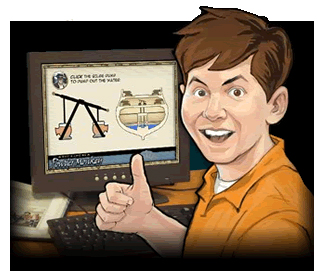

|
"I would rather entertain and hope that people learn something than educate people and hope they are entertained." — Walt Disney I first learned the terms Educational Technology and Instructional Design about four years ago. I was right, they were cool. I continued to research and discovered that there are entire Masters and Doctoral degree programs dedicated to these areas. I knew I wanted more education, but didn’t know how far I need to go. I researched websites, called program coordinators, emailed professors from a variety of schools to determine which course of study seemed most interesting and appropriate. I found the right place. My first two weeks of Educational Technology had a profound impact. I was excited about something new. This was, in reality, a very big deal. When I quit showbiz, I’d hoped to at least identify a vocation I could tolerate and feel like I was adding some value, but I had not set myself up to expect I’d discover a new path I’d be genuinely enthusiastic about. Not only was I excited, I began to identify a number of elements indigenous to both this field and my artistic endeavors. As I read about ADDIE and the process of Instructional Design I drew parallels between Analysis, Design, Development, Implementation and Evaluation; and the creative process involved in production, acting, writing, rehearsing, improvising and design; the collaboration I was familiar with. These connections have stayed with me throughout my studies. As I’ve progressed through the program they have informed my choice of projects and peripheral activities. As you might expect they play a role in my reflection too. Flow "Flow" a concept developed by psychologist Mihaly Csikszentmihalyi I first learned about the theory of Flow in Professor Dodge’s Exploratory Learning Through Educational Simulation & Games. As with many discoveries made during my studies, it wasn’t a new concept to me, but rather a name and face for a phenomenon I’ve known and experienced, but never been able to put into context, in this case not outside the artistic or abstract experience. Actors sometimes describe this sensation as “being connected”; athletes refer to it as being “in the zone.” These are performance experiences, but within the realm of learning we often perform. The application of the principles of flow are most clearly defined by what Csikszentmihalyi describes in The Conditions of Flow, three principles that, when met, provide an environment by which learners have the best opportunity to realize this phenomenon. These include:
A term Csikszentmihalyi, uses to support the value of these phenomenon within learning environments is Absorption , which he defines as,“conceptually related to openness to experience . . . positively associated with experiential involvement.” (Csikszentmihalyi, et al., 2005) These principles are represented to varying degrees in the each of the major projects I developed for Professor Dodge’s class: my Self-interview segment of the Learning Motivation & Fun exercise fairly well describes a personal version of this phenomenon. My group eGame Project, and my Systems Standard, the board game, Clean Slate, have the requisite element to create this type of experience for students. Implicit in all of these is the large role that improvisation plays, not only in the execution of the game, but there is also ample room for this in the design and development of learning. Improvisation is a device often used by performers to attain the very essence of flow. As a tool for design, the Instructional Designer seeks to expand their own creativity through challenging themselves in this manner. (Jasinski, 2001.) Anecdotally, my most successful professional experience in the role of educator, as a corporate trainer working with professional sales associates, is predicated heavily on the Conditions of Flow,. In this case we developed a simulated learning environment, based on real-world scenarios, and placed participants in these environments to role-play with clear goals, a full understanding of their abilities relative to the challenges they face, and the presence of agents providing immediate forms of evaluation. Success here was not only measured by the positive feedback from the participants, but also by the evaluative expertise of their peers and managers as participants and observers. With the appropriate conditions met, and an assumed level of comfort on the part of the participants, Flow is achieved when there is a natural connection between the learner and the task. They accept the immediate feedback as a part of the experience as opposed to a judgment and can adjust accordingly. Appropriate conditions allow learners to realize their full potential, and do so in a safe, and productive learning environment. Why is this important? Flow is described as an optimal experience. The opportunity to build learning environments that are positive, joyous and fun has tremendous application in all forms of education. These environments are further explored in the following. Simulated Learning Environments The history of Simulated or Virtual Learning environments harkens back to an 18th century New England correspondence course in the art of “short-hand.” Promoted to potential students by it’s Boston-based instructor, as “[P]erfectly instructed as those that live in Boston.” The first recorded case of Distance Learning. In his Guide to E-Learning, Michael Allen talks about involvement and engagement as key factors that lead to success in learning (Allen, 2003). Today Simulated Learning Environments take many forms, Virtual web-based worlds such as 2nd Life and Sony PS3 Home, are populated with avatars representing participants. Here students, teachers and virtual assistants can engage in traditional or more informal methods of learning. Such environments may take the form of role-playing, through games, or scenario-based training, or simply be a forum for discussion and interaction. Self-contained learning modules can represent realistic real-word situations that test problem solving skills, procedures and principles. In these environments, the authenticity of tasks is crucial, and relate directly to job-performance and learning outcomes. (Allen, 2003) Well-crafted, these environments often seamlessly employ means of assessment through formative or intrinsic feedback that may not need take the form of identifiable evaluations such as quizzes or tests, but rather through consequences of choices. Learners know they have succeeded,or failed by measure of the success of their tasks. Concepts such as “branching” and “skip-logic” support these processes, allowing designers to consider consequences of learner choices, and apply appropriate responses. It has been something of a personal quest over the last two years to identify opportunities for involvement in both research and development of simulated learning environments. To date, my efforts have yielded mixed results. The majority of relevant information seems to come almost exclusively from studies and organizations based in Europe and Australia. Research and development that I have been able to identify in the states tends to stem not from the perspective of educational technology, but rather information science and technology, focusing heavily on mathematical and computational theories involved in creating virtual environments. This has puzzled me. However, my involvement with the Association for Educational Communications and Technology (“AECT”) has provided some valid sources. I planned my activities at last year’s AECT conference in Anaheim heavily around attending any workshop or graduate paper presentation – no matter how obscure – that addressed simulated and virtual learning environments. (On more than one occasion I was asked if I was in the wrong room as I was the only one attending the presentation). It appeared that the research these students were conducting was, for the most part, in nascent stages and have not yet yielded much in the way of data that shows strong efficacy, or otherwise. The good news is that the despite the dearth of research supporting strong learning outcomes, there seems to be a great deal of enthusiasm in the academic and professional community to support the use of virtual environments in education and training. Currently, I am assigned to a study in Edtec 590, working with Sony PlayStation® investigating, amongst other things, the use of HOME, the PlayStation Network’s virtual world. I’m thrilled to be part of this project, it’s exactly the kind of opportunities I’d hope for when I began this program. My concerns. I have not found much in the way of valid answers regarding whether or not there is evidence to suggest virtual environments are producing positive educational results. Through my involvement with AECT, I have had opportunity to engage several doctoral students regarding this issue, and was intrigued that many, somewhat reluctantly, shared similar concerns. One student, who’s who presentation on the role of Second Life in distance education, noted that they apparently are beginning to see results in studies regarding its application to language training, have been positive. This is encouraging, I do hope to find more evidence when I can devote appropriate time to this quest. Yet, given the enthusiasm surrounding the use of simulated and virtual environments in teaching, and the potential for industry involvement in their development, there is some cause to wonder at the motives of certain stakeholders. The billion dollar video game industry would benefit greatly from this development and have a giant new market supplemented by tax payer dollars. While I’m a very big fan of games I’m also wary of toys in teachers clothing. If ever I had cause to "guard against inappropriate use" of technology this would be a valid place to voice it. My professional goal is to develop and implement simulated learning environments. Intellectually it is the most stimulating concept I have encountered in my educational and professional research. And while I am committed to opportunities in this arena, I am cautious of the generalizations I have already begun to recognize. I’ve heard many educators voice frustration over investment in ineffective and inapplicable technologies and resources, simply for the sake of intervention or change. This brings me to my third topic of interest, the polar opposite. Successive Approximation Successive Approximation, in the context of Michael Allen’s version, could be perceived in conflict with my earlier ideas. Successive Approximation is practical, to the point and impatient. Flow is an abstract idea, and by the standards of Successive Approximation, probably represent “depth over breadth.” (Allen, 2003) Simulated Learning certainly doesn’t contradict Successive Approximation but the ideal circumstances would likely be too burdensome for this process to tolerate. Metaphorically speaking, if Flow were a Yoga Instructor, Successive Approximation would be the Spin Class Teacher who barges in during Namaste and starts setting up for the 4:00pm Super-Burn. Yet, for it’s caustic manner I am drawn to this phenomenon of Successive Approximation within the realm of instructional design. As I allude to in my Communication Standard, it is a bit aggressive in the approach, but the practicality is effective in cutting through obstacles that I have personally encountered trying to design and develop instruction. To me Successive Approximation represents the tool I would pay extra for and rely heavily on to do the work that does not come so instinctively. I have not perfected the use of Successive Approximation in my design, in fact I would admit at times my performance techniques would be loathed by Successive Approximation. What I have included in my presentation was my first real attempt at it. But I have committed myself to the concept. I have faced enough short-cuts and watered down versions of improvement initiatives to know that moving quickly and cheaply is valued. To get the best out of limited time and resources, my goal is now to practice this process. When faced with these circumstances as an instructional designer, I expect to be prepared to bring value to these all too common conditions and find a marginally acceptable compromise. Rather than stumble into a cycle of feeling constrained by limitations Allen, M. (2003) Michael Allen's Guide to e-Learning, Hoboken, NJ, John Wiley & Sons, Inc. Csikszentmihalyi, M., Abuhamdeh, S., & Nakamura, J. (2005). Handbook of Competence and Motivation. AJ. Elliot and C.S. Dweck (Eds.), Flow (pp. 598-608). New York, NY: Buildford Press. Retrieved from: http://academic.udayton.edu/jackbauer/CsikFlow.pdf Jasinski, M., (2001, September) E-games: Improvisation through open platform design. Paper presented at the meeting of Moving Online 11: A conference to explore the challenges for Workplaces, Colleges and Universities, Queensland, Australia Mager, R.F. and Pipe, P. (1997). Analyzing Performance Problems (3rd ed.), Rossett, A. and Schafer, L. (2007). Job Aids & Performance Support, |
- Justin Kennedy | 2011 © All rights reserved.
Privacy Policy 
- Vinton Ave.
Los Angeles, CA 90034 
- Tel.: (323) 555-1212
E-mail: sdsu@justin-kennedy.net






 I had just extricated myself from two decades of ups and downs in the entertainment industry and was not sure what there was in the real world that might capture my interest. In what felt at the time like a corny Tony Robbins seminar exercise, I made a list of my skills, interest and experiences; revised, culled, and edited it down to a dozen or so terms and started typing them into to Google, as I continued to reduce the terms and the returns in the searches became more specific. Instructional Design appeared a few time before I realized it wasn’t Industrial Design – and that it is Educational Technology they are referring to, not Information Technology. When I saw Instructional Technology I decided these were good terms to stop and investigate. They all sounded cool.
I had just extricated myself from two decades of ups and downs in the entertainment industry and was not sure what there was in the real world that might capture my interest. In what felt at the time like a corny Tony Robbins seminar exercise, I made a list of my skills, interest and experiences; revised, culled, and edited it down to a dozen or so terms and started typing them into to Google, as I continued to reduce the terms and the returns in the searches became more specific. Instructional Design appeared a few time before I realized it wasn’t Industrial Design – and that it is Educational Technology they are referring to, not Information Technology. When I saw Instructional Technology I decided these were good terms to stop and investigate. They all sounded cool.